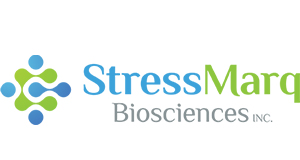Amyloid Beta 1-42 Oligomers
Human Synthetic Amyloid Beta 1-42 Oligomers
SKU
STRSPR-488B
Packaging Unit
100 µg
Manufacturer
Stressmarq Biosciences
Availability:
loading...
Price is loading...
Target: Amyloid Beta Oligomers
Nature: Synthetic (TFA preparation)
Swiss-Prot: P05067
Expression System: N/A
Protein Length: 42 amino acids
Amino Acid Sequence: DAEFRHDSGYEVHHQKLVFFAEDVGSNKGAIIGLMVGGVVIA
Purification: N/A
Purity: >95%
Storage Buffer: Phosphate buffer (PB) pH 7.4 and 10 mM NaCl
Protein Size: 4.5 kDa
Conjugate: No Tag
Cellular Localization: Cell Membrane / Intracellular Vesicles
Scientific Background: Our Amyloid Beta 1-42 (Aβ42) Oligomers are generated from Amyloid Beta Peptide 1-42 pre-treated with 1,1,1,3,3,3-Hexafluoro-2-propanol (HFIP) as previously published (1,2). Our Aβ42 oligomers present as globular oligomers when observed under TEM and AFM, and have a unique dimer/trimer and oligomer signal on a Western Blot with an anti-amyloid beta antibody. Our Aβ42 oligomers were also demonstrated to be toxic to primary rat cortical neurons in a dose-dependent manner.In the brain, amyloid beta peptide (Aβ) is generated by protease cleavage of amyloid precursor protein (APP), which aggregates into oligomers, protofibrils, fibrils and ultimately plaques in neurodegenerative diseases. The accumulation of Aβ plaques in the brain is considered a hallmark of Alzheimer’s disease (AD), and most of the drugs tested for AD in the past 20 years have targeted amyloid beta accumulation (3). Soluble Aβ oligomers isolated from the brains of AD patients or those generated in vitro potently impaired synapse structure and function (4). Aβ oligomers generated in vitro were toxic to PC12 cells (5) and SH-SY5Y cells (6). Aβ was demonstrated to interact with tauopathies to affect neurodegeneration in AD patients (7) and accumulations of Aβ were shown to be associated with lower survival rates in Parkinson’s disease patients with dementia (8).
References: 1. Stine et al. 2003. JBC. 278(13):11612-22. doi: 10.1074/jbc.M2102072002. Ahmed et al. 2010. Nature Structural & Molecular Biology. 17(5):561-7. doi: 10.1038/nsmb.17993. Panza et al. 2019. Nat Rev Neurol. 15:73-88 https://doi.org/10.1038/s41582-018-0116-64. Shankar et al. 2008. Nat Med. 14(8):837-842. doi: 10.1038/nm17825. Chromy et al. 2003. Biochemistry. 42:12749-12760. doi: 10.1021/bi030029q6. Kayed et al. 2003. Science. 300(5618): 486-489. doi: 10.1126/science.10794697. Want et al. 2016. JAMA Neurol. 73(9):1070-7. doi: 10.1001/jamaneurol.2016.20788.Kotzbauer et al. 2012. Arch Neurol. 69(10): 1326-1331. doi: 10.1001/archneurol.2012.1609
Field of Use: Not for use in humans. Not for use in diagnostics or therapeutics. For in vitro research use only.
Nature: Synthetic (TFA preparation)
Swiss-Prot: P05067
Expression System: N/A
Protein Length: 42 amino acids
Amino Acid Sequence: DAEFRHDSGYEVHHQKLVFFAEDVGSNKGAIIGLMVGGVVIA
Purification: N/A
Purity: >95%
Storage Buffer: Phosphate buffer (PB) pH 7.4 and 10 mM NaCl
Protein Size: 4.5 kDa
Conjugate: No Tag
Cellular Localization: Cell Membrane / Intracellular Vesicles
Scientific Background: Our Amyloid Beta 1-42 (Aβ42) Oligomers are generated from Amyloid Beta Peptide 1-42 pre-treated with 1,1,1,3,3,3-Hexafluoro-2-propanol (HFIP) as previously published (1,2). Our Aβ42 oligomers present as globular oligomers when observed under TEM and AFM, and have a unique dimer/trimer and oligomer signal on a Western Blot with an anti-amyloid beta antibody. Our Aβ42 oligomers were also demonstrated to be toxic to primary rat cortical neurons in a dose-dependent manner.In the brain, amyloid beta peptide (Aβ) is generated by protease cleavage of amyloid precursor protein (APP), which aggregates into oligomers, protofibrils, fibrils and ultimately plaques in neurodegenerative diseases. The accumulation of Aβ plaques in the brain is considered a hallmark of Alzheimer’s disease (AD), and most of the drugs tested for AD in the past 20 years have targeted amyloid beta accumulation (3). Soluble Aβ oligomers isolated from the brains of AD patients or those generated in vitro potently impaired synapse structure and function (4). Aβ oligomers generated in vitro were toxic to PC12 cells (5) and SH-SY5Y cells (6). Aβ was demonstrated to interact with tauopathies to affect neurodegeneration in AD patients (7) and accumulations of Aβ were shown to be associated with lower survival rates in Parkinson’s disease patients with dementia (8).
References: 1. Stine et al. 2003. JBC. 278(13):11612-22. doi: 10.1074/jbc.M2102072002. Ahmed et al. 2010. Nature Structural & Molecular Biology. 17(5):561-7. doi: 10.1038/nsmb.17993. Panza et al. 2019. Nat Rev Neurol. 15:73-88 https://doi.org/10.1038/s41582-018-0116-64. Shankar et al. 2008. Nat Med. 14(8):837-842. doi: 10.1038/nm17825. Chromy et al. 2003. Biochemistry. 42:12749-12760. doi: 10.1021/bi030029q6. Kayed et al. 2003. Science. 300(5618): 486-489. doi: 10.1126/science.10794697. Want et al. 2016. JAMA Neurol. 73(9):1070-7. doi: 10.1001/jamaneurol.2016.20788.Kotzbauer et al. 2012. Arch Neurol. 69(10): 1326-1331. doi: 10.1001/archneurol.2012.1609
Field of Use: Not for use in humans. Not for use in diagnostics or therapeutics. For in vitro research use only.

 Deutsch
Deutsch










